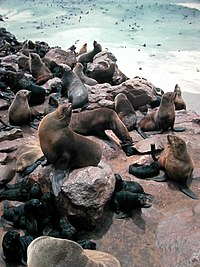
Photo from wikipedia
Fur seal populations in the Southern Hemisphere were plundered in the late 1700s and early 1800s to provide fur for a clothing industry. Millions of seals were killed resulting in… Click to show full abstract
Fur seal populations in the Southern Hemisphere were plundered in the late 1700s and early 1800s to provide fur for a clothing industry. Millions of seals were killed resulting in potentially major ecosystem changes across the Southern Hemisphere, the consequences of which are unknown today. Following more than a century of population suppression, partly through on-going harvesting, many of the fur seal populations started to recover in the late 1900s. Australian fur seals (Arctocephalus pusillus doriferus), one of the most geographically constrained fur seal species, followed this trend. From the 1940s to 1986, pup production remained at approximately 10,000 per year, then significant growth commenced. By 2007, live pup abundance had recovered to approximately 21,400 per year and recovery was expected to continue However, a species-wide survey in 2013 recorded a 20% decline, to approximately 16,500 live pups. It was not known if this decline was due to 2013 being a poor breeding year or a true population reduction. Here we report the results of a population-wide survey conducted in 2017 and annual monitoring at the most productive colony, Seal Rocks, Victoria that recorded a large decline in live pup abundance (-28%). Sustained lower pup numbers at Seal Rocks from annual counts between 2012–2017 (mean = 2908 ± 372 SD), as well as the population-wide estimate of 16,903 live pups in 2017, suggest that the pup numbers for the total population have remained at the lower level observed in 2013 and that the 5-yearly census results are not anomalies or representative of poor breeding seasons. Potential reasons for the decline, which did not occur range-wide but predominantly in the most populated and long-standing breeding sites, are discussed. To enhance adaptive management of this species, methods for future monitoring of the population are also presented. Australian fur seals occupy several distinct regions influenced by different currents and upwellings: range-wide pup abundance monitoring enables comparisons of ecosystem status across these regions. Forces driving change in Australian fur seal pup numbers are likely to play across other marine ecosystems, particularly in the Southern Hemisphere where most fur seals live.
Journal Title: PLoS ONE
Year Published: 2022
Link to full text (if available)
Share on Social Media: Sign Up to like & get
recommendations!